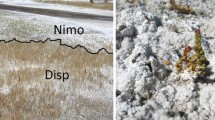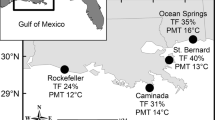Abstract
Coastal baldcypress (Taxodium distichum) forests are being killed in the southern United States as a result of saltwater intrusion. Tank studies have indicated substantial intraspecific variation in salt tolerance within baldcypress populations, but only one field study has been conducted and it used a limited seed source. The major objective of this project was to expand the collection range of baldcypress across the southeastern United States and determine if there are baldcypress populations that can survive and grow in saltwater damaged areas. Seeds were collected in 1996 from eight estuarine areas (James River = VA; Cape Fear River = NC; Winyah Bay = SC; Ogeechee River = GA; Ochlockonee River = FL; Mobile Bay = AL; Biloxi River=MS; Chalmette = LA). Seeds were stratified and planted, and seedlings were grown for 2 years before planting in two abandoned ricefields on Hobcaw Barony near Georgetown, South Carolina in 1999. Salinity levels reached 18.5ppt during 2001 at the peak of the worst drought on record. By 2002, the only seedlings surviving were those from LA, AL, and FL. After 5 years in the field, LA seedlings were the best performers with a mortality rate of only 27%. More detailed analyses of the biologic and genetic characteristics of trees growing in the LA site need to be completed to determine if they represent a source of baldcypress seed possessing greater tolerance to saline conditions. If so, seeds need to be collected and nurseries established to grow seedlings to help restore degraded wetland swamp areas along the Gulf and Atlantic coasts.
Similar content being viewed by others
References
J.A. Allen (1992) ArticleTitleCypress-tupelo swamp restoration in southern Louisiana Restoration Manage. Notes 10 188–189
J.A. Allen (1994) Intraspecific variation in the response of baldcypress (Taxodium distichum) to salinity. Ph.D. Thesis Louisiana State University Baton Rouge
J.A. Allen J.L. Chambers D. McKinney (1994) ArticleTitleIntraspecific variation in the response of Taxodium distichum seedlings to salinity For. Ecol. Manage. 70 203–214
J.A. Allen S.R. Pezeshki J.L. Chambers (1996) ArticleTitleInteraction of flooding and salinity stress on baldcypress (Taxodium distichum) Tree Physiol. 16 307–313 Occurrence Handle14871777
C.L. Brown G.N. Montz (1986) Baldcypress: the Tree Uniquethe Wood Eternal Claitor’s Publishing Division Baton RougeLouisiana
Caffey R.H. and Leblanc B. 2002. Closing the Mississippi Rive Gulf Outlet: environmental and economic considerations. Interpretive Topic Series on Coastal Wetland Restoration in Louisiana, Coastal Wetland Planning, Protection, and Restoration Acts. National Sea Grant Library No. LSU-G-02-004, 8 p.
Conner W.H. 1993. Artificial regeneration of baldcypress in three South Carolina forested wetland areas after Hurricane Hugo. In: Brissette J.C. (ed) Proceedings of the Seventh Biennial Southern Silvicultural Research Conference. U.S. Department of Agriculture, Forest Service, Southern Forest Experiment Station: New Orleans, LA. Gen. Tech. Rep. SO-93, pp. 185–188.
W.H. Conner (1994) ArticleTitleThe effect of salinity and waterlogging on growth and survival of baldcypress and Chinese tallow seedlings J. Coastal Res. 10 IssueID(4) 1045–1049
W.H. Conner (1995) ArticleTitleWoody plant regeneration in three South Carolina Taxodium/Nyssa stands following Hurricane Hugo Ecol. Eng. 4 277–287 Occurrence Handle10.1016/0925-8574(94)00054-9
W.H. Conner (1998) Impact of hurricanes on forests of the Atlantic and Gulf coasts A.D. Laderman (Eds) Coastally Restricted Forests Oxford University Press New York, NY 271–277
W.H. Conner G.R. Askew (1992) ArticleTitleResponse of baldcypress and loblolly pine seedlings to short-term saltwater flooding Wetlands 12 IssueID(3) 230–233
W.H. Conner J.W., Day SuffixJr. R.H. Baumann J. Randall (1989) ArticleTitleInfluence of hurricanes on coastal ecosystems along the northern Gulf of Mexico Wetl. Ecol. Manage. 1 IssueID(1) 45–56
W.H. Conner K.W. McLeod J.K. McCarron (1997) ArticleTitleFlooding and salinity effects on growth and survival of four common forested wetland species Wetl. Ecol. Manage. 5 99–109 Occurrence Handle10.1023/A:1008251127131
Conner W.H., McLeod K.W., Inabinette L.W., Parrish V.H. and Reed M.R. 1999. Successful planting of tree seedlings in wet areas. In: Haywood J.D. (ed) Proceedings of the Tenth Biennial Southern Silviculture Research Conference. U.S. Department of Agriculture, Forest Service, Southern Research Station, Asheville, NC. Gen. Tech. Rep. SRS-30, pp. 201–204.
Gresham C.A. 1993. Changes in baldcypress-swamp tupelo wetland soil chemistry caused by Hurricane Hugo induced saltwater inundation. In: Brissette J.C. (ed) Proceedings of the Seventh Biennial Southern Silvicultural Research Conference. U.S. Department of Agriculture, Forest Service, Southern Research Station, New Orleans, LA. Gen. Tech. Rep. SO-93, pp. 171–175.
C.A. Gresham T.M. Williams D.J. Lipscomb (1991) ArticleTitleHurricane Hugo wind damage to southeastern U.S. coastal forest tree species Biotropica 23 420–426
Guntenspergen G.R., Vairin B.A. and Burkett V. 1998. Overview of coastal wetland global climate change research. In: Gutenspergen G.R. and Vairin B.A. (eds) Vulnerability of Coastal Wetlands in the Southeastern United States: Climate Change Research Results, 1992–1997. 7. U.S. Department of Interior, U.S. Geological Survey, National Wetlands Research Center, Lafayette, LA. Rep. USGS=BRD=BSR-1998-0002.089-9, pp. 1–6.
W.M. Harlow E.S. Harrar (1969) Textbook of Dendrology McGraw Hill Book Company New York
D.D. Hook M.A. Buford T.M. Williams (1991) ArticleTitleImpact of Hurricane Hugo on the South Carolina Coastal Plain Forest J. Coastal Res. SI 8 291–300
K.W. Krauss J.L. Chambers J.A. Allen (1998) ArticleTitleSalinity effects and differential germination of several half-sib families of baldcypress from different seed sources New Forests 15 53–68 Occurrence Handle10.1023/A:1006572609171
K.W. Krauss J.L. Chambers J.A. Allen D.M. Soileau SuffixJr. A.S. DeBosier (2000) ArticleTitleGrowth and nutrition of baldcypress families planted under varying salinity regimes in LouisianaUSA J. Coastal Res. 16 IssueID(1) 153–163
L. Loope M. Duever A. Herndon J. Snyder D. Jansen (1994) ArticleTitleHurricane impact on uplands and freshwater swamp forest BioScience 44 238–246
A.P.C. Marsinko T.J. Straka J.L. Baumann (1993) ArticleTitleHurricane Hugo: a South Carolina update J. For. 91 IssueID(9) 9–17
K.W. McLeod J.K. McCarron W.H. Conner (1996) ArticleTitleEffects of inundation and salinity on photosynthesis and water relations of four southeastern coastal plain forest species Wetl. Ecol. Manage. 4 IssueID(1) 31–42
W.T. Penfound E.S. Hathaway (1938) ArticleTitlePlant communities in the marshlands of Southeastern Louisiana Ecol. Monogr. 8 1–56 Occurrence Handle1:CAS:528:DyaA1cXlsVGisQ%3D%3D
S.R. Pezeshki R.D. DeLaune H.S. Choi (1995) ArticleTitleGas exchange and growth of baldcypress seedlings from selected U.S. Gulf coast populations: responses to elevated salinities Can. J. For. Res. 25 1409–1415
S.R. Pezeshki R.D. DeLaune W.H. Patrick SuffixJr. (1986) ArticleTitleGas exchange characteristics of baldcypress (Taxodium distichum): evaluation of responses to leaf aging, flooding and salinity Can. J. For. Res. 16 1394–1397 Occurrence Handle1:CAS:528:DyaL2sXhvFejtbo%3D
S.R. Pezeshki R.D. DeLaune W.H. Patrick SuffixJr. (1987) ArticleTitleResponse of baldcypress (Taxodium distichum L. var. distichum) to increases in flooding salinity in Louisiana’s Mississippi River Delatic Plain Wetlands 7 1–10
S.R. Pezeshki R.D. DeLaune W.H. Patrick SuffixJr. (1990) ArticleTitleFlooding and saltwater intrusion: potential effects on survival and productivity of wetland forests along the U.S. Gulf Coast For. Ecol. Manage. 33/34 287–301
S.L. Pimm G.E. Davis L. Loope C.T. Roman T.J. Smith SuffixIII J.L. Tilmant (1994) ArticleTitleHurricane Andrew BioScience 44 224–229
Williams T.M. 1993. Salt water movement within the water table aquifer following Hurricane Hugo. In: Brissette J.C. (ed) Proceedings of the Seventh Biennial Southern Silvicultural Research Conference. U.S. Department of Agriculture, Forest Service, Southern Research Station, New Orleans, LA. Gen. Tech. Rep. SO-93, pp. 177–184.
Y.Q. Xu W.B. Long (1983) ArticleTitleThe adaptive character and species choice of main planting trees of farmland shelterbelt in the Pearl River Delta Scientia Silvae Sinicae 19 225–234
T.M. Yanosky C.R. Hupp C.T. Hackney (1995) ArticleTitleChloride concentrations in growth rings of Taxodium distichum in a saltwater-intruded estuary Ecol. Appl. 5 785–792
Author information
Authors and Affiliations
Corresponding author
Rights and permissions
About this article
Cite this article
Conner, W.H., Inabinette, L.W. Identification of salt tolerant baldcypress (Taxodium distichum (L.) Rich) for planting in coastal areas. New Forest 29, 305–312 (2005). https://doi.org/10.1007/s11056-005-5658-y
Received:
Accepted:
Issue Date:
DOI: https://doi.org/10.1007/s11056-005-5658-y




